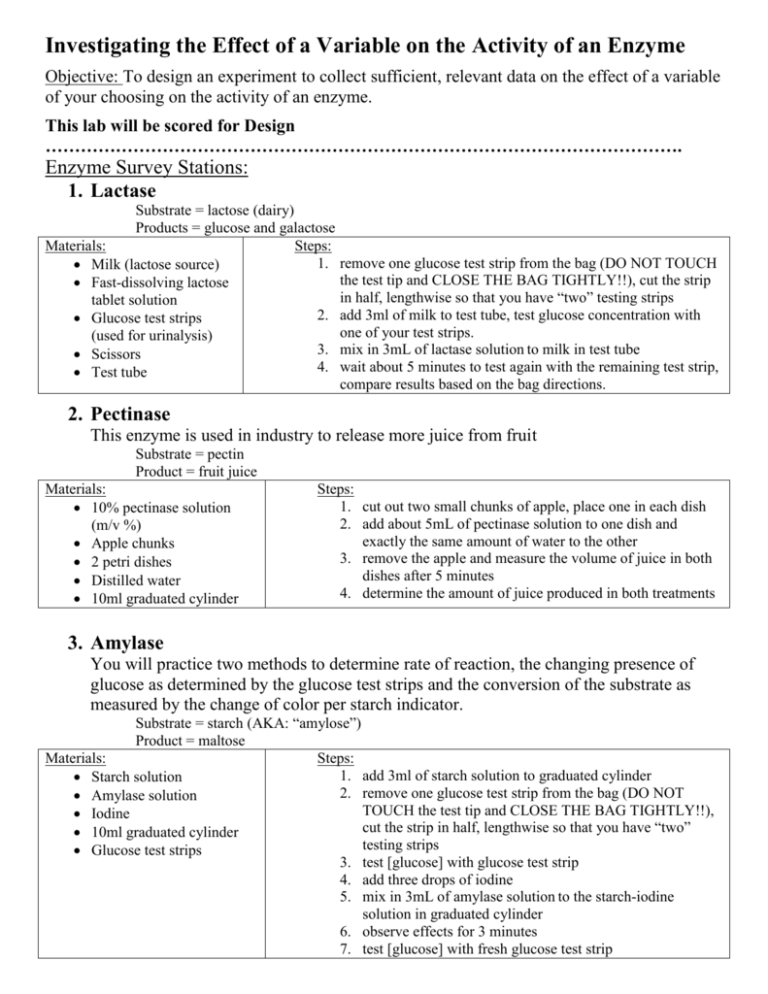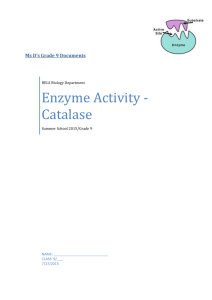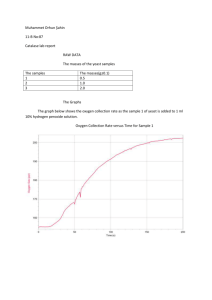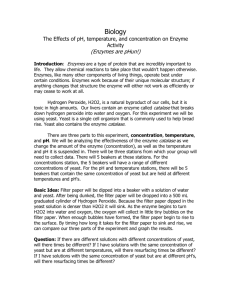Enzyme Survey Lab
advertisement

Investigating the Effect of a Variable on the Activity of an Enzyme Objective: To design an experiment to collect sufficient, relevant data on the effect of a variable of your choosing on the activity of an enzyme. This lab will be scored for Design ………………………………………………………………………………………………. Enzyme Survey Stations: 1. Lactase Substrate = lactose (dairy) Products = glucose and galactose Materials: Steps: 1. Milk (lactose source) Fast-dissolving lactose tablet solution 2. Glucose test strips (used for urinalysis) 3. Scissors 4. Test tube remove one glucose test strip from the bag (DO NOT TOUCH the test tip and CLOSE THE BAG TIGHTLY!!), cut the strip in half, lengthwise so that you have “two” testing strips add 3ml of milk to test tube, test glucose concentration with one of your test strips. mix in 3mL of lactase solution to milk in test tube wait about 5 minutes to test again with the remaining test strip, compare results based on the bag directions. 2. Pectinase This enzyme is used in industry to release more juice from fruit Substrate = pectin Product = fruit juice Materials: 10% pectinase solution (m/v %) Apple chunks 2 petri dishes Distilled water 10ml graduated cylinder Steps: 1. cut out two small chunks of apple, place one in each dish 2. add about 5mL of pectinase solution to one dish and exactly the same amount of water to the other 3. remove the apple and measure the volume of juice in both dishes after 5 minutes 4. determine the amount of juice produced in both treatments 3. Amylase You will practice two methods to determine rate of reaction, the changing presence of glucose as determined by the glucose test strips and the conversion of the substrate as measured by the change of color per starch indicator. Substrate = starch (AKA: “amylose”) Product = maltose Materials: Steps: 1. add 3ml of starch solution to graduated cylinder Starch solution 2. remove one glucose test strip from the bag (DO NOT Amylase solution TOUCH the test tip and CLOSE THE BAG TIGHTLY!!), Iodine cut the strip in half, lengthwise so that you have “two” 10ml graduated cylinder testing strips Glucose test strips 3. test [glucose] with glucose test strip 4. add three drops of iodine 5. mix in 3mL of amylase solution to the starch-iodine solution in graduated cylinder 6. observe effects for 3 minutes 7. test [glucose] with fresh glucose test strip 4a. Catalase –pt. 1 Substrate = hydrogen peroxide Product = water and oxygen Enzyme source: beef liver, yeast Materials: Steps: 1. To each deep well add: Deep well chamber Well 1: a small chunk of raw liver Raw beef liver/suspension Well 2: 3ml of yeast suspension*NOTE BELOW Yeast suspension Well 3: a small chunk of potato 10ml graduated cylinder Well 4: nothing! Potato chunks/potato 2. pour in 3ml of hydrogen peroxide to each of the 4 wells suspension 3. observe effects Hydrogen peroxide in a 4. empty contents of wells into trash dropper bottle 5. add a small chunk of potato to the test tube of the gas collection Gas collection apparatus apparatus 6. add 3 ml of hydrogen peroxide to the test tube 7. stopper the test tube and place tubing under glass container of apparatus 8. observe the volume of gas/ rate of bubbles produced *To make yeast suspension, add the following into a beaker (Make a fresh suspension right before experimenting.): 100 ml warm water (37-40C, but no hotter or the yeast will die or enzymes will denature). 1 packet of yeast (approx. 7g) Let the solution sit for 5 minutes before testing. **To prepare a liver or potato suspension, homogenize (blend!) 0.5 to 1.5 g of tissue in 100 mL of cold water. Keep the suspension on ice until used in an experiment. 4b. Catalase – pt.2 Substrate = hydrogen peroxide Product = water and oxygen Enzyme source: beef liver, yeast Materials: Steps: 1. Put 4ml of substrate solution (peroxide) into two wells Deep well chamber 2. Punch two filter paper discs Yeast suspension 3. Make sure to swirl the cup of yeast solution before you use it because Hydrogen peroxide in a the yeast will settle to the bottom. Using the forceps, dip ONE paper dropper bottle disc into the small cup of yeast/catalase solution for 5 seconds, then filter paper place them onto a small piece of paper towel for one minute to hole-puncher remove excess solution. 4. Then, with timer ready, quickly place an enzyme-soaked disc all the forceps way to the bottom of the well before releasing it. Start the watch when the disc is released at the bottom of the well, and stop it when the disc first starts to rise from the bottom of the well. 5. Rinse the forceps clean and then perform step 4 with the disc that has not been soaked Enzyme Survey QUESTIONS General: 1. Name 3-4 variables that could affect the rate of an enzymatic reaction ……………………………………………………………………………………………………………………… ……………………………………………………………………………………………………………………… 2. Describe what enzymes do as “biological catalysts” ……………………………………………………………………………………………………………………… ……………………………………………………………………………………………………………………… 3. Enzymes typically function at a range of temperatures. Why might different enzymes have differing ranges of temperatures in which they can function? ……………………………………………………………………………………………………………………… ……………………………………………………………………………………………………………………… ……………………………………………………………………………………………………………………… ……………………………………………………………………………………………………………………… 4. Explain the effect of temperature (decrease, increase…) on the rate of an enzymatic reaction. ……………………………………………………………………………………………………………………… ……………………………………………………………………………………………………………………… ……………………………………………………………………………………………………………………… ……………………………………………………………………………………………………………………… ……………………………………………………………………………………………………………………… ……………………………………………………………………………………………………………………… ……………………………………………………………………………………………………………………… ……………………………………………………………………………………………………………………… ……………………………………………………………………………………………………………………… 5. When analyzing data, state what happens to enzymes when the temperature gets “too hot” and the rate of the reaction drops to zero. ……………………………………………………………………………………………………………………… 6. What would be the effect of dropping temperatures, below the optimal range for an enzyme, on the reaction rate of a reaction catalyzed by that enzyme? ……………………………………………………………………………………………………………………… a. Why? ……………………………………………………………………………………………………………………… ……………………………………………………………………………………………………………………… ……………………………………………………………………………………………………………………… 7. Infer the optimal temperature for an enzyme found in the human body. ………………………………… 8. Given the reaction: A + B yields C, What would you expect to happen to the concentration of each, A, B and C, as the reaction proceeds? ……………………………………………………………………………………………………………………… ……………………………………………………………………………………………………………………… Lactase: 9. Does lactase likely function as an enzyme at human body temperature? Why do you think? ……………………………………………………………………………………………………………………… ……………………………………………………………………………………………………………………… ……………………………………………………………………………………………………………………… 10. Other than testing for the presence of glucose as in indicator of the reaction occurring, name two other substances you could test for a change in the presence of that would provide you with reaction rate data. ……………………………………………………………………………………………………………………… Pectinase 11. How would you control the impact of the initial “juiciness” of the apple so that it would not be included in your data of “juice produced as a result of the reaction you are testing”? ……………………………………………………………………………………………………………………… ……………………………………………………………………………………………………………………… ……………………………………………………………………………………………………………………… 12. What if the experiment lasted longer, what effect would you expect to see? Would there ever be an end to the volume of juice produced in this reaction – If so, why? ……………………………………………………………………………………………………………………… ……………………………………………………………………………………………………………………… ……………………………………………………………………………………………………………………… Amylase 13. How could you quantify your observations? What “measurement data” would you like to collect? ……………………………………………………………………………………………………………………… ……………………………………………………………………………………………………………………… ……………………………………………………………………………………………………………………… 14. Why does all of the iodine eventually turn “yellowish/brown” in this reaction? Explain what happened to both, the reactants and the products as the reaction proceeded. ……………………………………………………………………………………………………………………… ……………………………………………………………………………………………………………………… ……………………………………………………………………………………………………………………… ……………………………………………………………………………………………………………………… ……………………………………………………………………………………………………………………… ……………………………………………………………………………………………………………………… 15. What would you expect to happen if, at the end of the enzymatic reaction as indicated by your observations, you added more amylase to the test tube? ……………………………………………………………………………………………………………………… ……………………………………………………………………………………………………………………… ……………………………………………………………………………………………………………………… Catalase 16. What do you think the effect would be if the liver tissue had been cooked? Frozen? ……………………………………………………………………………………………………………………… ……………………………………………………………………………………………………………………… ……………………………………………………………………………………………………………………… ……………………………………………………………………………………………………………………… ……………………………………………………………………………………………………………………… ……………………………………………………………………………………………………………………… ……………………………………………………………………………………………………………………… ……………………………………………………………………………………………………………………… 17. What are the bubbles produced in the reaction? ………………………… 18. Why do beef liver, yeast and potatoes all contain catalase? (THINK, I am looking for a relatively simple answer here…) ……………………………………………………………………………………………………………………… ……………………………………………………………………………………………………………………… Catalase Activity Almost all chemical reactions that occur in living organisms are catalyzed by enzymes. Enzymes are globular proteins, responsible for most of the chemical activities of living organisms. They act as catalysts, substances that reduce activation energy, or the energy it takes to get a reaction started. Enzymes are not destroyed or altered during the process. They are extremely efficient and may be used over and over again. One enzyme may catalyze thousands of reactions every second. Many factors in a cell’s environment, like temperature, pH, concentration and salinity, affect the action of an enzyme. Changes in these conditions may change the shape of the enzyme making it useless, a process called denaturation. In this investigation, you will conduct an experiment to determine the effect of temperature on an enzyme catalyzed reaction. In every cell of the body, hydrogen peroxide, H2O2, is produced as a waste product. However, hydrogen peroxide kills living cells. Although H2O2 is toxic to most living organisms, many organisms are capable of enzymatically destroying the H2O2 before it can do much damage. H2O2 can be converted to oxygen and water, as follows. 2H2O2 → 2H2O + O2 Because your liver is responsible for detoxifying your blood, your liver cells contain a lot of catalase to break down H2O2 into harmless H2O and O2. Potato and yeast cells also contain catalase. When the H2O2 encounters the yeast catalase, it bubbles, as the gaseous O2 escapes.









